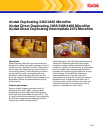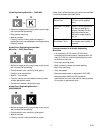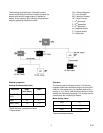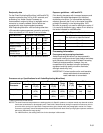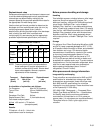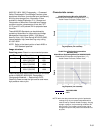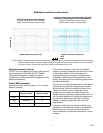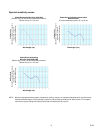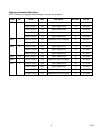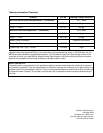
5D-32
Replenishment rates
Development/transport time and transport rates are set
to achieve desired photographic aims; replenishment
rate settings are determined by multiplying the
transport speed by the required replenishment rates for
the appropriate film width being used.
Use the chart and formula provided to determine the
developer and fixer replenishment rates (mL/min) by
multiplying transport speed (ft/min) (which is
determined by dividing the path length of the developer
tank in feet by the dwell time in seconds and
multiplying by 60; see example) and the appropriate
processor replenishment specification (mL/linear ft).
NOTE: These are starting point recommendations.
Actual settings may require adjustments to
maintain process activity levels. Shorter dwell
times are acceptable; however, exposure
adjustments will be necessary.
A calculation of replenisher rate follows:
For Processor: Allen M-70 Processor
Type of FIlm: 35 mm (2468 Microfilm)
Dwell: 70 seconds
Developer Film Path: 84 feet
Replenishment (Dev): 2 (from table above)
Calculated transport speed:
84 feet
x 60 sec/min = 72 feet/min
70 sec (transport speed)
Results:
72 feet/min x 2 mL/ft = 144 mL/min
replenishment rate for developer
Before-process handling and storage
Handling
Total safelight exposure, whether before or after image
exposure, should not exceed 30 minutes. For
darkroom handling, x468 and 2470 Microfilms should
use a Kodak 1 Safelight Filter / red or Kodak 2
Safelight Filter / dark red, in a suitable safelight lamp
with a 15-watt bulb, located at least 4 feet (1.2 meters)
from the film. x462 Microfilms should use a Kodak OA
Safelight Filter /greenish yellow, with the same lamp
distance conditions. When using gooseneck lamps
with contact printers, a Kodak 1 Safelight Filter / red is
required.
Storage
For optimum life of Direct Duplicating Microfilms (x468
and 2470), keep unopened packages at 55°F (13°C),
at 50 percent relative humidity or below, and protected
from radiation and x-rays. Film stored at higher
temperatures or humidities for a period of six months
or more may lose photographic speed or D-max.
Duplicating Microfilm (x462) can be stored at 70°F
(21°C) at 50 percent relative humidity or below, and
protected from radiation and x-rays. To avoid moisture
condensation on film that has been refrigerated, allow
cold film to reach approximate room temperature
before opening the package (about 3 hours if
refrigerated, 5 hours if frozen).
After-process and storage information
Image stability and keeping
These microfilms are manufactured to ANSI and ISO
specifications for extended term storage use. When
processed as recommended, these microfilms meet
both ANSI and ISO specifications for microfilms
intended for long-term storage. These microfilms have
a Life Expectancy LE-500 rating.
ISO 19801 2002, Photography — Processed Silver-
Gelatin Type Black-and-White Film — Specifications
for Stability, state that the maximum permissible
concentration of thiosulfate ion is 0.014 grams per
square meter (1.4 micrograms per square centimeter).
Thiosulfate limits for Class 1 grain apply to this
microfilm.
Replenishment mL/Linear Ft
16 mm 35 mm 105 mm
Dev Fix Dev Fix Dev Fix
Kodak
Prostar
0.75 0.75 1.5 1.5 N/A N/A
Deep
Tank
1.00 1.25 2.0 2.5 6.0 7.5
Transport
speed X
(ft/min)
Replenishment/
feet of film =
(mL/Lft)
Replenishment
rate
(mL/min)



